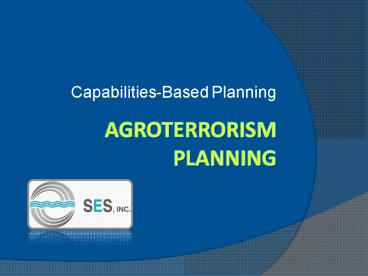Agroterrorism Planning - PowerPoint PPT Presentation
1 / 20
Title:
Agroterrorism Planning
Description:
Help the community recover more quickly from the effects of disaster ... 'Plans are worthless, planning is everything' General Dwight D. Eisenhower. SES Model ... – PowerPoint PPT presentation
Number of Views:94
Avg rating:3.0/5.0
Title: Agroterrorism Planning
1
Agroterrorism Planning
- Capabilities-Based Planning
2
Why Plan?
- Mitigate the effects of a disaster
- Help the community recover more quickly from the
effects of disaster - Coordinate a consistent response to the effects
and impacts of disasters of all types (natural or
manmade)
Plans are worthless, planning is everything
General Dwight D. Eisenhower
3
SES Model
- State and local buy-in
- Seamless integration of response
- Seven phases
- FACT components
4
(No Transcript)
5
(No Transcript)
6
(No Transcript)
7
(No Transcript)
8
(No Transcript)
9
(No Transcript)
10
(No Transcript)
11
FACT Components
- All plans need to have the following components
- F functional
- A applicable
- C comprehensive
- T thorough
12
State and Local Buy-in
- Requires collaboration and cooperation
- Collaboration consists of
- A commitment to participate in shared decision
making - A willingness to share information, resources and
tasks - A professional sense of respect for individual
team members
13
National Preparedness Goal
- HSPD-8 calls for a National Preparedness Goal
that establishes measurable priorities, targets
and a common approach to developing needed
capabilities. - Utilizes a Capabilities-Based Planning approach.
- The central objective is the identification of
target levels of capabilities. - Capabilities are combinations of resources to
achieve a measurable outcome.
14
Capabilities-Based Planning
- The Target Capabilities List (TCL) identifies 36
target capabilities, one of which deals with
food. - All-hazards planning
- Focus efforts on identifying and developing the
critical capabilities from the TCL to perform the
critical tasks from the Universal Task List for
the National Planning Scenarios. - Tasks help identify planning components.
- Scenarios provide common planning factors.
15
National Planning Scenarios
- Develop appropriate capabilities to address range
of scenarios that will best prepare the nation
for terrorist attacks, major disasters and other
emergencies. - Scenario 13 addresses food contamination
- Scenario 14 focuses on Foot-and-Mouth Disease
(FMD)
16
Defining Target Capabilities
- A capability may be delivered with any
combination of properly planned, organized,
equipped, trained and exercised personnel that
achieve the intended outcome. - Designed to assist federal, state, local and
tribal entities. - Understand and define roles in a major event.
- Define required capabilities.
- Provide additional resource information.
17
Acquiring Needed Capabilities
- Requests for preparedness assistance will
ultimately be expressed as capability needs. - Why a capability is needed and how will it be
used. - What function the capability will perform and who
will need it. - When the capability will be available and how
much will it cost. - What key performances comprise the capability and
how will it be supported. - What skills will be required and how to train
responders.
18
Relative to Food and Agriculture
- Protect Mission Area Capability
- Food and Agriculture Safety and Defense
- Ensure food safety and security through the
development and adoption of agriculture and food
safety programs, procedures, guidelines and
regulations. - Ensure the nations commercial supply of food is
safe and secure following an incident.
19
Relative to Animal Health
- Respond Mission Area Capability
- Animal Health Emergency Support
- The capability to protect, prevent, detect,
respond to, and recover from threats and
incidents that would result in the disruption of
U.S. livestock, other domestic animals, and
wildlife related industries. - Response to large-scale national and regional
emergencies as well as to smaller-scale
incidents.
20
Need for Planning
- All levels of government should have plans,
policies and procedures in place for food and
agriculture safety and security.































